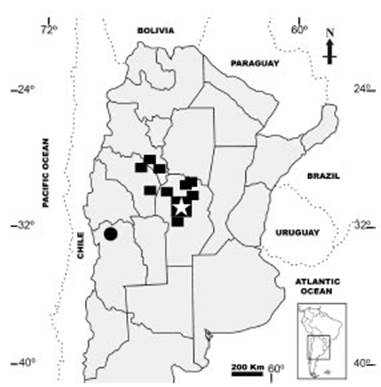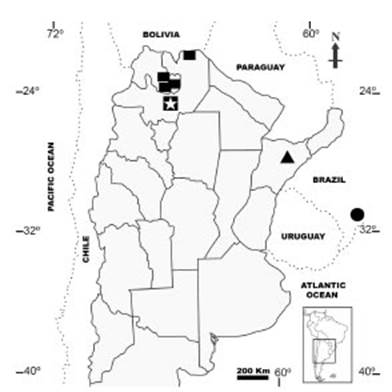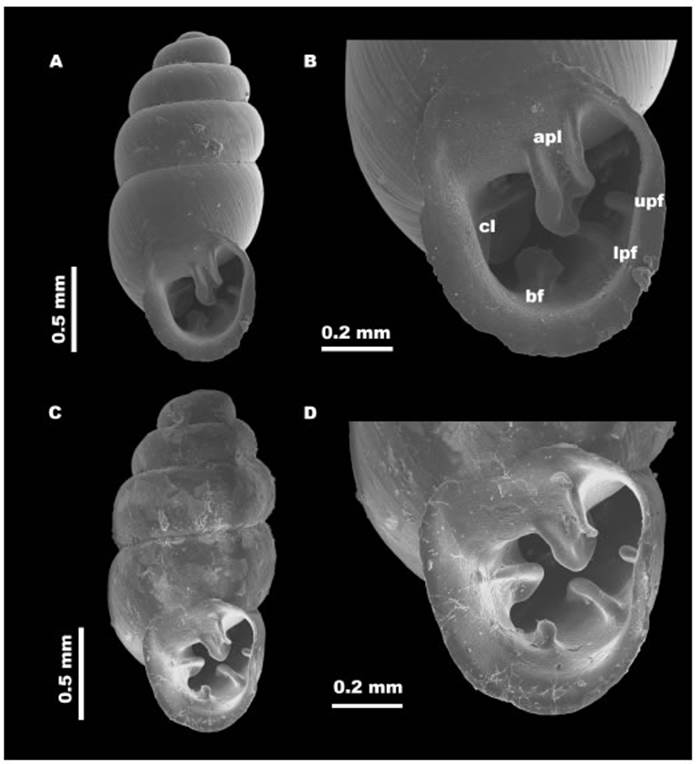INTRODUCTION
Argentina is situated in southern South America, with a surface of about 2.800.000 km². The country has a wide variety of biomes and soil types, including several arid, semiarid, wetland, forest and pasture areas. Many environments show marked degradation signs due to the ad vancement of human activities as agriculture, livestock, mining and forestry (Bertonatti & Corcuera, 2000).
The genus Gastrocopta Wollaston, 1878 has an almost worldwide distribution, except Europe. Most of the species in the genus inhabit in North America (Pilsbry, 1948; Bank, 2017). They are differentiated by shell morphology, in particular by the variety of apertural callous barriers, which are well developed only in fully grown specimens (Pokryszko, 1997; Miquel & Brito, 2019).
Gastrocopta has been scarcely studied in Argentina, where only eight recent species were reported during the last century, all of them from subtropical and temperate areas (Doering, 1879; Hylton Scott, 1945, 1948; Miquel & Parent, 1996). Fossil species were studied from the Early Miocene of Santa Cruz province (Miquel & Rodriguez, 2015), Early Pliocene of Mendoza (Turazzini & Miquel, 2014), and Late Holocene of Entre Ríos (Miquel & Aguirre, 2011).
In this paper we describe two new spe cies inhabiting the central and northern part of Argentina, and we report G. iheringi (Suter, 1900) for the first time in the country.
MATERIAL AND METHODS
The material studied here was collected in Argentina and southern Brazil, and is housed at the Museo Argentino de Ciencias Naturales “Bernardino Rivadavia” (Buenos Aires) and Museo de La Plata (La Plata). The acronyms of these collections are MACN-In (Invertebrate Division, Museo Argentino de Ciencias Naturales “Bernardino Rivadavia”), MLP (Museo de La Plata) and MPM (Museo Regional Provincial “Padre Manuel Jesús Molina”, Río Gallegos).
All the available specimens are adult shells. The methodology to study the apertural barriers follows Miquel & Brito (2019). The abbreviations used to identify the barriers are: apl: angulopari etal, ipl: infraparietal, cl: columellar, scl: subcol umellar, for lamellae; bf: basal, lpf: lower-palatal, upf: upper-palatal, for folds. After each descrip tion, a formula, e.g., [ap + c + sc/0] l + [b + lp + up] f, is given. Outside the first brackets an “l” indicates these are lamellae, while an “f” after the second brackets means folds. When a bar rier may be either present or absent it is coded as sc/0.
Shells were observed and measured un der a stereoscopic microscopy; some specimens were coated with gold-palladium and imaged by Scanning Electronic Microscopy (MACN).
RESULTS
Gastrocopta Wollaston, 1878
Type species. Pupa acarus (Benson, 1856), by subsequent designation of Pilsbry (1916: 6).
The species analyzed in this paper are mem bers of the uncertainly defined group or subgenus Gastrocopta (Immersidens) Pilsbry & Vanatta, 1900, characterized by the angular lamella unit ing to the parietal one at the inner end of the former, the two diverging forwards to shape to gether a Greek letter λ, or a reversed y. They also have two palatal folds, not standing on a callous ridge; the lower one is often deeply immersed (Pilsbry, 1948: 894).
Gastrocopta dicrodonta (Doering, 1879)
(Fig. 1)

Fig. 1 Distribution of Gastrocopta dicrodonta (Doering, 1879) Villavicencio, Mendoza (type locality: black circle), and Gastrocopta subandina n. sp. (black squares; white star: Holotype MLP 8902-1. Rumi Huasi, Cabana, Córdoba).
Pupa dicrodontaDoering, 1879: 83.
Gastrocopta (Immersidens) dicrodonta:Pilsbry, 1916: 100; Parodiz, 1957: 129; Fernández, 1973: 31.
Gastrocopta dicrodonta:Hylton Scott, 1948: 247.
Translation of the Latin original descrip tion by Pilsbry (1916: 100). “Shell minute, pupoid, smooth, substriatulate, a little shining, brownish-corneous. Spire subconical, the sum mit tapering, rather than obtuse. Whorls 5 ½ to 6, a little convex, the last about two-fifths the length. Aperture oval-rounded, with 5 (-6) teeth: the first, on the parietal wall, largest, twisted, bifid (forked or biramose), the right branch elon gated to the margin of peristome, the other re mote from the margin of the aperture; second tooth columella, tortuous, angulate, lengthened within, three pliciform palatal teeth. Peristome expanded, scarcely reflected, whitish, the mar gins nearly connected, right margin curved. Length 1.8 to 2, width 0.9 mm; aperture 0.7 to 0.8 mm. long”.
Type specimens and other materials. Unkown.
Type locality. Originally recorded from Mendoza, Córdoba and San Luis provinc es; Parodiz (1957: 129) tried to restrict it to Villavicencio (Mendoza) (Fig. 1), with no indica tion of analyzed materials.
Remarks. The absence of either a type specimen or any original illustration hinders a comparison with other species. It is here considered a species inquirenda.
Gastrocopta iheringi (Suter, 1900)
(Figs. 2 A-C, 3)

Fig. 2 Gastrocopta iheringi (Suter, 1900). A-C. MACN-In 30623-1, Carlos Pellegrini, Corrientes Province. A, C. General view. B. Apertural view. Abbreviations: anguloparietal (apl) and columellar (cl) lamellae and basal (bf), lower-palatal (lpf) and upper-palatal (upf) folds.

Fig. 3 Distribution of Gastrocopta iheringi (Suter, 1900) (black triangle; black circle: Holotype (Bollaxa city, Rio Grande do Sul, Brazil); Gastrocopta maxbirabeni n. sp. (black squares; white star: Holotype MLP 8910-2. Lumbreras, Salta).
Pupa (Bifidaria) iheringiSuter, 1900: 336, Pl. III, figs. 8-8a.
Gastrocopta (Immersidens) iheringiPilsbry, 1916: 101, pl. 17, fig. 16.
Gastrocopta iheringiRamírez et al., 2003: 274; Simone, 2006: 116, figs. 346 A-B; Veitenheimer-Mendes & Pedroso de Oliveira, 2012: 181, figs. 1-4; Salvador et al., 2017: 139, Fig. 8; Salvador, 2021: 62, Figs 1-3.
Diagnosis. Shell pupoid, oblong, cylindrical or conical, 5 apertural barriers: anguloparietal and columellar lamellae, and basal, lower-palatal and upper-palatal folds; barriers occupying large size in inner of peristome.
Description. Shell pupoid, oblong or conical, light brown color, spire obtuse, not prominent, rimate, 4.5- 5.25 convex whorls with growth lines very low but marked, oblique and irregularly par allel; the last whorl about 55% the total length; shallow suture. Peristome oval and reflected; 5 apertural barriers. Angular and parietal lamel lae joined at base diverging forwards; angular lamella small and very curved to the periphery as compared with the parietal one; columellar lamella in inner of peristome, slightly inclined, strong, very concave and with slight expansion of its wall; basal fold semicircular, elevated; lower-palatal fold semicircular and slightly expanded to inner of peristome; upper-palatal fold slightly smaller than the basal fold, semicircular and el evated. Barrier formula: [ap + c] l + [b + lp + up] f.
Measurements of the illustrated material. MACN-In 30623-1: 2.33 x 1.13 mm, > 4 whorls; 2.60 x 1.20 mm, 5.25 whorls.
Syntypes. Brazil, Rio Grande do Sul, Bollaxa city (Museum Te Papa Tongarewa, Wellington, New Zealand, NMNZ 205848) (Salvador, 2021).
Type locality. Bollaxa city, Rio Grande do Sul, Brazil (Fig. 1).
Distribution. Argentina: Corrientes Province; Brazil: Rio Grande do Sul State (Fig. 1).
Examined material. Dry. Brazil: MACN-In 36251. Bolacha, Rio Grande, Rio Grande do Sul, Brazil, in leaf litter taken under a fallen trunk, soil somewhat sandy, coll. F. Scarabino, 11-II-1995, 3 fragm. spm. Argentina: MACN-In 30623-1. Corrientes: Colonia Carlos Pellegrini, coll. I. Apóstol, X-1966, 6 spm; MLP 8899-2. Colonia Carlos Pellegrini, Laguna Iberá, coll. I. Apóstol, I-1966, 30 spm.
Gastrocopta subandina n. sp.
(Figs. 1, 4 A-D)

Fig. 4 Gastrocopta subandina n. sp. A-B. Holotype. MLP 8902-1. Rumi Huasi, Cabana, Córdoba. A. General view. B. Apertural view. C. Paratype. MACN-In 9439-2. Lomas del Potrero, Chumbicha, Catamarca. C. General view. D. MLP 11834. Aguas de Ramón, Córdoba. Apertural view. Abbreviations: anguloparietal (apl), columellar (cl) and subcolumellar (scl) lamellae, and basal (bf), lower-palatal (lpf) and upper-palatal (upf) folds.
LSID. urn:lsid:zoobank.org:act:9CBF1813-E04C-4171-9E80-829D1D2396C2
Type specimens. Dry. Holotype: MLP 8902-1, Córdoba, Cabana, Rumi Huasi, 1947, coll. M. Birabén. Paratypes: MLP 8902-2, from type lo cality, 2 spm, and MACN-In 9783, Catamarca, Chumbicha, Lomas del Oeste, VIII-1918, coll. E. Budin, 8 spm.
Diagnosis. Shell cylindrical or oblong-conical, with 6 apertural barriers: anguloparietal, colu mellar and subcolumellar (sometimes absent) lamellae, and basal, lower-palatal and upper-pal atal folds. Apertural barriers small with a hori zontal columellar lamella.
Description. Shell minute, long, cylindrical or oblong-conical, light brown color, spire obtuse, not prominent, rimate, 6 convex whorls, with growth lines very low but marked, oblique and irregularly parallel; the last whorl about 57% the total length; shallow suture. Peristome oval or rounded, reflected, sometimes with a slight con striction in upper-palatal area; 6 apertural bar riers. Anguloparietal lamella joined in the inner region of peristome diverging forwards; angular lamella bent towards the palatal wall; parietal lamella more elongated than angular lamella and bent towards the columellar wall; columellar lamella semicircular, horizontal, well expanded; subcolumellar lamella similar to a tubercle or callus, sometimes in the inner corner of the colu mellar lamella, which is sometimes absent; basal fold semicircular, slightly elongated towards in ner peristome; lower-palatal fold semicircular and prolonged towards inside the peristome; up per-palatal fold small, semicircular, elevated and slightly elongated towards inside the peristome, sometimes slightly hidden due to constriction of peristome. Barrier formula: [ap + c + sc/0] l + [b + lp + up] f.
Measurements of illustrated material. Holotype: MLP 8902-1: 2.47 x 1.04 mm, 5.25 whorls. Paratype: MACN-In 9439-2: 2.86 x1.30 mm, > 6 whorls.
Etymology. In reference to the species’ dis tribution on the Subandean hills of western Argentina.
Type locality. Rumi Huasi, Cabana, Córdoba (Fig. 1).
Distribution. Argentina: Catamarca, Córdoba and La Rioja provinces (Fig. 1).
Other examined material. Dry. Catamarca: MLP 8867-1. Quebrada de la Cébila, 13-III-1950, coll. H. Scott, 13 spm. Córdoba: MACN-In 10129-B. Jesús María, IX-1919, coll. M. Doello-Jurado, 21 spm; MACN-In 32796-2. Barranca del arroyo de La Posta de Macha, Totoral, 1 spec. MLP 11834. Aguas de Ramón, Minas, Córdoba, 1-VI-1969, 4 spm; MLP 8855-1. Arroyo Saldán, 4 spm; MLP 2246-1. Arroyo Saldán, 12 spm; MLP 8864-1. Barranca del arroyo de Cerro Colorado, 21-III-1949, coll. M. Birabén & M.I. Hylton Scott, 1 spec.; MLP 8859-2. Cabana, VIII-1950, coll. Birabén, 88 spm; MLP 8902-3. Cabana, Rumi Huasi, 1947, coll. M. Birabén, 73 spm; MLP 10185. Cabana, Rumi Huasi, 1947, coll. M. Birabén, 1 spec.; MLP 8863-1. El Sauce, Calamuchita, I-1962, coll. M. Viana, 4 spm; MLP 8855-1. Entre San Salvador [norte de Capilla del Monte, Punilla] y Ongamira, 6-III-1950, 7 spm; MLP 8913-1. San Pedro Norte, Tulumba, 21-III-1949, coll. Hylton Scott, 2 spm; La Rioja: MACN-In 18361. Sierra Las Torres, Iliar, General Belgrano. Col. M. Gómez, III-1929, 1 spec. MLP 8892. Anillaco, 26-II-1939, 2 spm fragm.
Remarks. Gastrocopta subandina n. sp. shows some morphological variations: while some shells have a cylindrical form, other ones have an oblong or conical form. Shells collected from Catamarca have an infraparietal lamella and a lower-pala tal fold inside the peristome, a longer parietal lamella, and they lack a subcolumellar lamella.
Comparisons. Gastrocopta subandina n. sp. is longer than G. maxbirabeni n. sp., and its aper tural barriers are simpler than those of the lat ter. Gastrocopta subandina has an anguloparietal lamella shorter than in G. iheringi and G. maxbi rabeni, and does not have a concave and curved columellar lamella as G. maxbirabeni and G. iher ingi do. Gastrocopta dicrodonta (Doering, 1879) is known to be smaller, pupoid, subconical, and differnt from Gastrocopta subandina (Pilsbry, 1916: 100). Some specimens of G. subandina have a subcolumellar lamella, which is absent in the other species described in this paper.
Gastrocopta maxbirabeni n. sp.
(Figs. 3, 5A-D)

Fig. 5: Gastrocopta maxbirabeni n. sp. A, B. Holotype, MLP 8910-2. Lumbreras, Salta. A. General view. B. Apertural view. C, D. MLP 8860. Valle Grande, Jujuy. C. General view. D. Apertural view. Abbreviations: anguloparietal (apl) and columellar (cl) lamellae and basal (bf), lower-palatal (lpf) and upper-palatal (upf) fold.
LSID. urn:lsid:zoobank.org:act:3B2D8A83-5365-4B16-9C96-A8BFD3FF6004
Type specimens. Dry. Holotype: MLP 8910-2, Salta, Lumbreras, coll. M. Birabén, 18-XII-1954. Paratypes: MLP 8910-3, from the type locality (3 spm).
Diagnosis. Shell pupoid, cylindrical or conical, with 5 or 6 apertural barriers: anguloparietal, infraparietal (sometimes absent) and columel lar lamellae, and basal, lower-palatal and upper-palatal folds. Anguloparietal and columellar la mellae and the basal fold occupy a large space. Apertural barriers small with a columellar la mella slightly concave and oblique.
Description. Shell pupoid, oblong or conical, light brown color, spire obtuse, not prominent, rimate, 4.5- 5.25 convex whorls with growth lines very low but marked, oblique and irregularly par allel; the last whorl about 58% the total length; shallow suture. Peristome rounded square, re flected; 5 or 6 apertural barriers. Angular and pa rietal lamellae joined at base diverging forwards; parietal lamellae curved to the periphery, larger than the angular lamella; infraparietal lamella small, similar to a callus or tubercle, sometimes absent; columellar lamella concave, bent towards the parietal wall, sometimes very strong; basal fold sometimes strong, semicircular and slightly prolonged towards inside the peristome; lower-palatal fold oblique, elongate, sometimes deeper in peristome than other folds; upper-palatal fold semicircular, elongate. Barrier formula: [ap + ip/0 + c] l + [b + lp + up] f.
Measurements of the illustrated material. MLP 8910-2: 2.08 x 1.04 mm, 5.5 whorls; MLP 8860: 2.08 x 1.04 mm, 5.25 whorls.
Type locality. Lumbreras, Salta, Argentina (Fig. 2).
Distribution. Argentina: Jujuy and Salta prov inces (Fig. 2).
Etymology. Dedicated to Dr Maximiliano (Max) Birabén, biologist, Dr M. I. Hylton Scott’s hus band and an important shell collector.
Examined. Dry. Jujuy: MLP 8860. Valle Grande, coll. M. Birabén, 3-XII-1950, 2 spm; MLP 8896. Sierra de Santa Bárbara (El Palmar), coll. M. Birabén, X-1947, 2 spm; MLP 8898-1. La Mendieta, Las Quinas, 1-VI-1947, 1 spec.; Salta: MLP 8886-2. Pocitos, 3 spm; MLP 8911-2. Lumbreras, coll. M. Birabén, 18-XII-1954, 47 spm.
Comparisons: Gastrocopta maxbirabeni n. sp. is shorter than G. subandina and it has stronger apertural barriers. These, mainly the angulopa rietal and, sometimes, the columellar lamellae, occupy a large area of the aperture, which allow differentiate from G. subandina. Gastrocopta maxbirabeni is also distinct from G. iheringi as the new species is larger, with a smaller number of whorls; the latter has a longer anguloparietal lamellae. Some specimens of G. maxbirabeni have an infraparietal lamella, which is absent in other species described in this paper.
DISCUSSION
Recent specimens of Gastrocopta have been collected from humid areas of South America. Semiarid areas of the subandean region of Argentina are here added as new records. From a physiographical viewpoint, these areas are en vironmentally similar to those from which the genus was described from and mainly studied in North America (Pilsbry, 1948).
Gastrocopta iheringi is known from Brazil. Here, it is also recorded from the Corrientes Province (Argentina). The record for Santa Fe Province (Miquel & Parent, 1996) was errone ous (Salvador, 2021); the image of the specimen does not resemble G. iheringi but to an indeter minate species of Gastrocopta. Mentions of G. iheringi from Peru (Ramírez et al., 2003) and Venezuela (Thompson & López, 1996) need to be confirmed.
A comparison to the type series of Gastrocopta patagonicaMiquel & Rodríguez, 2016, a fossil species from the late Early Miocene of the Santa Cruz Formation, is problematic because the para type (MPM PI 3315) shows the characteristic an guloparietal lamella of the here analyzed species, while in the holotype (MPM PI 3314) this area is hidden by sediment (Miquel & Rodríguez, 2016 (“2015”): fig. 3.1-3.4).
Up to now specimens have been collected from only seven out of the 23 provinces of Argentina, in scattered localities far apart from each other. We therefore consider that the spread of this ge nus is still understated in the country, and many new localities could be added with a larger sam pling.












 uBio
uBio 

